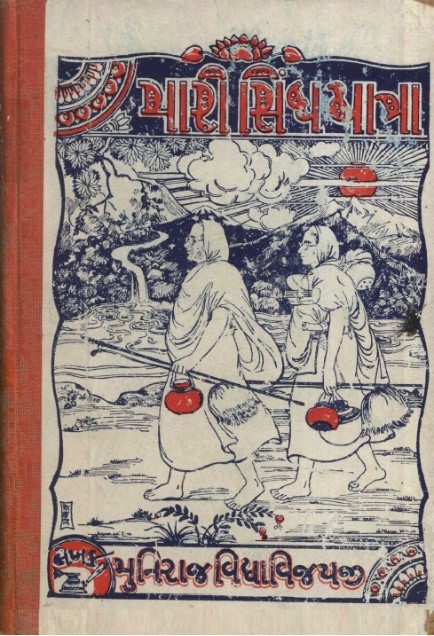
It is very well understood that during certain period in the past, Sindh was abundantly visited by Jain Sadhus

[Editor’s Note: This is 4th Part of a series of articles based on a pre-partition book named “મારી સિંધ યાત્રા” (“منهنجي سنڌ جو سفر”) in Gujarati authored by Jain Sadhu Shri Vidyavijayji, narrating his experiences of travel and stay in Karachi for about 2 and half a years between 1937 and 1939. It would be advisable to click on introductory article and read for better understanding of the series. – Nasir Aijaz, Editor Sindh Courier]
Vimal Shah, Mumbai
Vihar (Travel) of Jain Sadhus
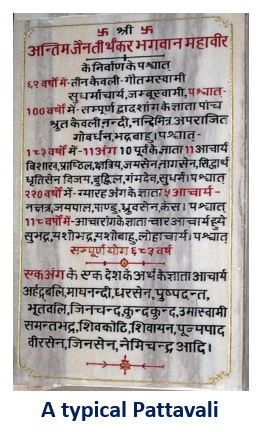 “It is obvious that Jain sadhus must have frequented in the past to the places where ancient Jain heritage is found. And it is also obvious that some or the other religious ceremonies also must have been performed where Jain sadhus would have frequented. Hundreds of evidence of Jain sadhus visiting Sindh are found in ancient ‘Pattavali’ (a record of a spiritual lineage of heads of Jain sadhus) and citations.
“It is obvious that Jain sadhus must have frequented in the past to the places where ancient Jain heritage is found. And it is also obvious that some or the other religious ceremonies also must have been performed where Jain sadhus would have frequented. Hundreds of evidence of Jain sadhus visiting Sindh are found in ancient ‘Pattavali’ (a record of a spiritual lineage of heads of Jain sadhus) and citations.
The oldest such evidence is of 400 years prior to the Vikram Samvat (about 479-480 BC) when Yakshadevsuri, the disciple of Ratnaprabhasuri has visited Sindh. And he had to undergo a lot of difficulties while traveling to Sindh. Impressed with the sermons of Yakshdevsuri, a prince named ‘Kakka’ had built Jain temples and later taken ‘diksha’ (initiated / renounced the world).
In the times of ‘Kakkasuri’, image of Neminath (22nd Tirthankar) was found during excavation at the fort of Marukot (known as Marot, Bahawalnagar). At that time the governing king was ‘Kaku’. He called the Jain community and handed over the image to them. The community built a beautiful temple and got the installation ceremony of the images performed by ‘Kakkasuri’.”
[Note by Vimal Shah: If there’s evidence of an image of a Tirthankar found from excavation at Marot, Bahawalpur around 480 BC, it proves that Jain temples must have been built there several hundred years prior to that period]
This tale is of the times before King Vikram.
The King Gardabhill of Ujjain, the capital of Malwa desh was a tyrant. He abducted Jain Sadhvi (initiated female – who has renounced world) Saraswati and carried her to his palace. The Jain Sangh (association of Jain community) pleaded a lot, but he did not listen. The great Aacharya Kalakacharya himself also tried a lot but Gardabhill did not pay heed. Finally, Kalakacharya asserted “Hey King! I will not be a true sadhu if I could not uproot you from throne”. The ascetic Jain Aacharya could not tolerate atrocities of a King, considered as guardian of the masses. Kalakacharya’s blood was boiling looking at the dignity of the women at risk due to the brutish behavior of the King. He left Ujjain and came to Sindh suffering a lot of difficulties.
Hundreds of evidence of Jain sadhus visiting Sindh are found in ancient ‘Pattavali’ (a record of a spiritual lineage of heads of Jain sadhus) and citations
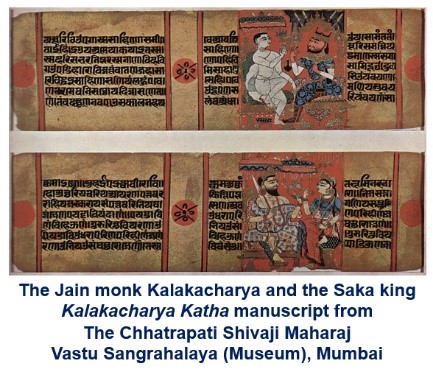 He crossed Sindhu River and met ‘Sakhi’ kings. It is said that these ‘Sakhis’ are the ones popularly known as ‘Scythians’. Scythians had concurred Sindh after Sikandar. Kalakacharya met 96 different Sakhi kings and guided them to Ujjain via Saurashtra, promising them to get the throne of Malwa and other territories. They challenge Gardabhill and uprooted him from the throne. Kalakacharya distributed various territories to the Shaka (Saka) kings and he himself remained a sadhu.
He crossed Sindhu River and met ‘Sakhi’ kings. It is said that these ‘Sakhis’ are the ones popularly known as ‘Scythians’. Scythians had concurred Sindh after Sikandar. Kalakacharya met 96 different Sakhi kings and guided them to Ujjain via Saurashtra, promising them to get the throne of Malwa and other territories. They challenge Gardabhill and uprooted him from the throne. Kalakacharya distributed various territories to the Shaka (Saka) kings and he himself remained a sadhu.
Thus, the visit of Kalakacharya to Sindh in the ancient times is a unique historical fact in the Jain history.”
[Note by Vimal Shah: The popular ‘Shak (Saka) Samvat’ is named after this Shaka dynasty. The abbreviation “V.S.” in the article is used for “Vikram Samvat”]
“V.S. 684 – Aacharya Devguptasuri gave sermons to Rai Gosal, and he had converted to Jainism. His dynasty was in Sindh until the 14th century of Vikram. The last person in this dynasty named Lunasha migrated to Marwar and his race became popularly known as Lunawat.
Around V.S. 1130 – Shri Jinvallabhsuri had performed the installation ceremony of images in a Jain temple in Marukot, which is known as Marot (Bahawalpur) and given Vyakhyan (sermons) on just one verse of ‘Updeshmala’ (a Jain scripture) for six months. In the same century, Padmaprabha – a disciple of Upadhyay (a title conferred to Jain sadhu) Jinabhadra, also came to Sindh for worshiping Tripura Devi. He had gone to Dambhrelpur. A generous Jain Shravak (a male of the Jain community) named ‘Dasha’ had organised a grand celebration. The King had constructed a Jain temple, and the Upadhyay had performed the installation ceremony of the images.
V.S. 1227 – Jinpatisuri had initiated three persons in Marukot. Marukot is described as a Maha Tirth (prime pilgrimage) in the ‘Vigyapti Triveni’ (a Jain scripture).
V.S. 1280 – Jinchandrasuri had initiated a few men and women in Uchchanagar.
V.S. 1282 – Aacharya Siddhisuri had performed the installation ceremony of the images in Jain temple built by Ladha Shah in Uchchanagar. At that time there were about 700 Jain families living there.
V.S. 1293 – Aacharya Kakkasuri had spent Chaturmas in Marukot (Marot). Kana Shah and Mana Shah of Choradia gotra (clan) had sponsored a Sangh to Siddhachal (a Tirth of prime importance in Palitana, Gujarat) and spent 7 lacs of the currency of that time.”
[Note by Vimal Shah: Jain sadhus keep traveling from place to place for 8 months of a year but stay at just one location during the 4 months of monsoon – known as Chaturmas. Chaturmas has a special significance since the religious ceremonies and penance are at their peak during the period. In the ancient time Kangra / Kangda in Himachal Pradesh, India was called Trigarta. Later when the kot or fort was built in the Old Kangra region, the area began to be known as Nagarkot.]
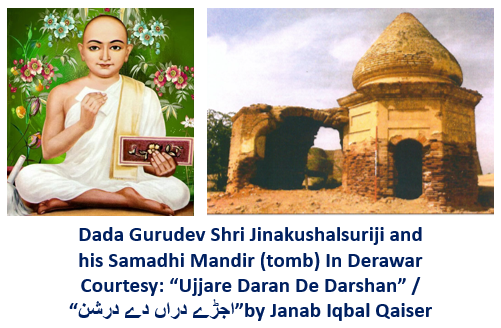 “V.S. 1309 – Sheth Vimalchandra had sponsored the installation ceremony of images by Jineshwarsuri in Nagarkot.
“V.S. 1309 – Sheth Vimalchandra had sponsored the installation ceremony of images by Jineshwarsuri in Nagarkot.
V.S. 1317 – Aacharya Devguptasuri came to Sindh and spent Chaturmas in Renukot. About 300 families converted to Jainism and installed image of Mahavirswami (24th Tirthankar) in a Jain temple.
V.S. 1345 – Upadhyay Jaykalash, disciple of Aacharya Siddhisuri travelled across Sindh and encouraged many good deeds by the community.
V.S. 1374 – Rajendracharya was conferred the title of Aacharya and a few people were initiated in Devrajpur.
V.S. 1384 – Jinakushalsuri had performed the installation ceremony of the images in Jain temples in Kayaspur and Renukot.
V.S. 1389 – Jinakushalsuri left for heavenly abode in Derawar and his disciple Jinamanakyasuri had gone there for darshan of his samadhi (tomb). On his return journey to Jaisalmer, he too left for heavenly abode due to lack of drinking water.
V.S. 1460 – Bhuvanratnacharya spent Chatuurmas in Drohadatta.
V.S. 1483 – Upadhyay Jaysagar spent Chaturmas in Mammarvahan.
V.S. 1483 – A Sangh had started from Faridpur for the pilgrimage of Nagarkot.
V.S. 1483 – Upadhyay Jaysagar came to Mubarakpur. There were about 100 Jain families at that time.
V.S. 1484 – Upadhyay Jaysagar spent Chaturmas in Malikwahanpur.
V.S. 1484 – Upadhyay Jaysagar went to pilgrimage of Kangda for worshiping Aadhinath (1st Tirthankar).
Jinsamudrasuri, the disciple of Jinchandrasuri of 16th century, had done meditation of ‘Panchnad’.
V.S. 1652 – After accomplishing ‘Panchnad’ Jinchandrasuri went to Derawal Nagar and worshipped the footprints (image) of Jinakushalsuri.
V.S. 1667 – Samaysundarji composed a scripture named ‘Shravak-Aaradhana’ in Uchchanagar. Shri Samaysundarji was a great poet, some of his Stavan are also found in Sindhi language.
Apart from the above, mention of many Jain events held in Multan, Khojawahan, Parashuroad Kot (fort), Tarpatak, Malikwahanpur, Gopachalpur, Kotimgram, Haji-Khan-Dera, Ismail-Khan-Dera, Bheranagar, Kharbara, Dunyapur, Sakkinagar, Nayanagar, Navrangkhan, Lodipur, etc., are found in Pattavalis and other scriptures.
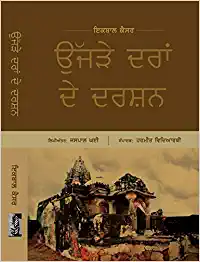
From the above, it is very well understood that during certain period in the past, Sindh was abundantly visited by Jain sadhus. There were many Jain temples. Many events contributing to the prosperity of Jainism were held. Ceremonies of Initiation and installation of images in temples were also held.
From the Samvat mentioned above we can see that from 400 years prior to V.S. until the 17th century of V.S. Jain Sadhus were visiting Sindh and Jain events were held persistently.
Thus, until we discover evidence of Jain sadhus visiting Sindh after the 17th century of V.S., we may believe in the last about 300 years they would not have visited Sindh.”
One Clarification (by the author of the book)
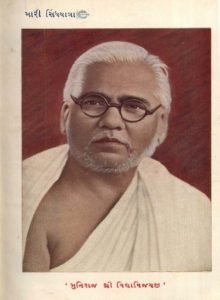
“It is important to clarify one thing. All the places mentioned above with respect to visits of Jain sadhus to Sindh and holding Jain events are not in Sindh today. Names of some of the places are not even traceable today. Some places are in the Bahawalpur state today, some in Punjab, some in Rajputana, and some of them are as far as the borders. There’s only one reason to this – which has already been explained earlier that the borders of Sindh were not the same as what we believe today. A large part of today’s Punjab, Afghanistan, North-East frontier, Balochistan, Bahawalpur, Rajputana, and Jaisalmer was part of Sindh. And that’s why those places are mentioned as part of Sindh (in this book). Truly, Sindh has been so much separated from all the regions above, that it has become painstaking and terrible for Jain sadhus to visit Sindh. Evidence of Jain sadhus visiting up to Nairunkot – that is today’s Hyderabad, or the colony of about 15 to 20 fishermen ‘Dhadbo bunder’ (دھدابو بندر) – known as Karachi today, in the ancient times are not found. However, it is definite that Jain sadhus have visited Sindh until the 17th century.” (Continues)
___________________
About the contributor of the series of Articles based on the book
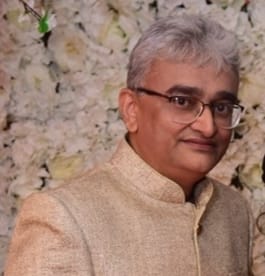 Vimal Shah is a follower of Jainism by birth and is based in Mumbai, India. He is a Computer Engineer and holds a Diploma in Jainology from Mumbai University. He has immense interest in reading, writing, studying, and teaching Jain Philosophical subjects. He conducts classroom as well as on-line sessions on Jain Philosophical courses. He has created several power point presentations with animation which he uses while teaching and has participated in several Jain Community events to present and explain the relevant subjects to the visiting audience. He has significantly contributed to the translation, reviewing, and editing of the set of books ‘Compendium of Jainism’ of JAINA, USA from English to Gujarati – an initiative of the JAINA India Foundation. He is also associated with a Project for the translation of Jain Aagams (Scriptures) from Gujarati to English and continues to study various subjects and remains a student of Jain Philosophy. He has a special interest in the history and preservation of the Jain Heritage in Pakistan, and is associated with the Jain Heritage Foundation, New Delhi.
Vimal Shah is a follower of Jainism by birth and is based in Mumbai, India. He is a Computer Engineer and holds a Diploma in Jainology from Mumbai University. He has immense interest in reading, writing, studying, and teaching Jain Philosophical subjects. He conducts classroom as well as on-line sessions on Jain Philosophical courses. He has created several power point presentations with animation which he uses while teaching and has participated in several Jain Community events to present and explain the relevant subjects to the visiting audience. He has significantly contributed to the translation, reviewing, and editing of the set of books ‘Compendium of Jainism’ of JAINA, USA from English to Gujarati – an initiative of the JAINA India Foundation. He is also associated with a Project for the translation of Jain Aagams (Scriptures) from Gujarati to English and continues to study various subjects and remains a student of Jain Philosophy. He has a special interest in the history and preservation of the Jain Heritage in Pakistan, and is associated with the Jain Heritage Foundation, New Delhi.
Click here for Part-I, Part-II, Part-III